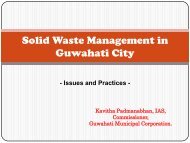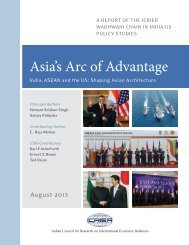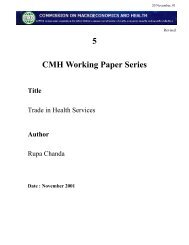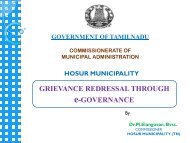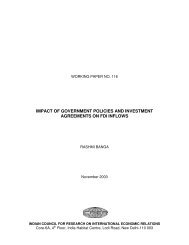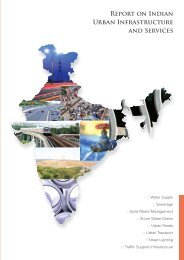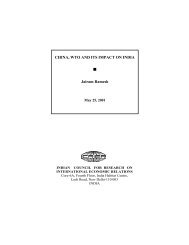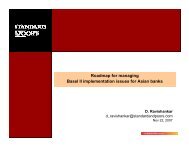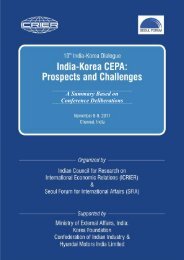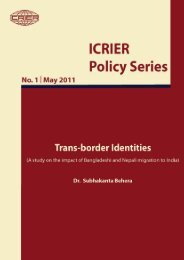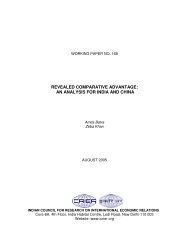Export Processing zones in India
Export Processing zones in India
Export Processing zones in India
Create successful ePaper yourself
Turn your PDF publications into a flip-book with our unique Google optimized e-Paper software.
Table 2 : Growth rates <strong>in</strong> <strong>Export</strong>s, Imports and Employment (1966-2002)<br />
Average annual Trend growth rates<br />
growth rate<br />
<strong>Export</strong> 42.4 39.2*<br />
Import 39.9 38.8*<br />
Value addition 2.9 1.5<br />
Employment 21.2 21.6*<br />
<strong>Export</strong>s/employment 24.3 14.6*<br />
* significant at 1%.<br />
Source : M<strong>in</strong>istry of commerce<br />
Three, growth of value addition had not been promis<strong>in</strong>g over this period. Average annual<br />
growth rate of value addition was as low as 2.9%. The trend growth rate <strong>in</strong> value addition was<br />
1.5%, which was not significantly different from zero. Apparently, imports also grew<br />
approximately at the same rate as exports. The above analysis suggests that exports and foreign<br />
exchange earn<strong>in</strong>gs of <strong>Export</strong> <strong>Process<strong>in</strong>g</strong> Zones ( EPZs) , <strong>in</strong> absolute terms, <strong>in</strong>creased substantially<br />
but the value addition rema<strong>in</strong>ed stagnated. There were thus no significant trends towards<br />
strengthen<strong>in</strong>g backward l<strong>in</strong>kages with the domestic markets.<br />
IV.2<br />
Share <strong>in</strong> total and manufactured exports<br />
The <strong>in</strong>crease <strong>in</strong> exports, employment and net foreign exchange earn<strong>in</strong>gs <strong>in</strong> absolute terms<br />
seems impressive. Was it impressive <strong>in</strong> relative terms also? To address this question we analysed<br />
the share of EPZs <strong>in</strong> total and manufactured exports. Our analysis <strong>in</strong>dicated that the share of<br />
EPZs <strong>in</strong> total exports and manufactured exports <strong>in</strong>creased from mere .07% and .14% respectively<br />
<strong>in</strong> 1973 to 4.3 % and 5.6% respectively <strong>in</strong> 2001. In 2002, their share <strong>in</strong> total exports and<br />
manufactured exports was slightly lower at 3.8% and 5.2% respectively. Apparently, EPZs'<br />
exports have <strong>in</strong>creased at a faster rate than overall/manufactured exports. Figure 1 however<br />
presents a more disaggregated picture. It shows that the share of EPZs <strong>in</strong> total exports rema<strong>in</strong>ed<br />
<strong>in</strong>significnat until 1975. In 1975, exports from Kandla started pick<strong>in</strong>g up. By this time Santacruz<br />
had also become operational. As a result, the share of the <strong>zones</strong> <strong>in</strong> total exports <strong>in</strong>creased rapidly.<br />
By 1985 , it had already touched the figure of 3% and 4.4 percent respectively. But the <strong>in</strong>crease<br />
<strong>in</strong> the share of EPZs <strong>in</strong> total/manufactur<strong>in</strong>g exports considerably slowed down after the mid<br />
1980s. This was despite the fact that four more <strong>zones</strong> became operational <strong>in</strong> that year.<br />
Apparently, EPZ and total export growth rates started converg<strong>in</strong>g <strong>in</strong> the late 1980s. To obta<strong>in</strong> a<br />
10



